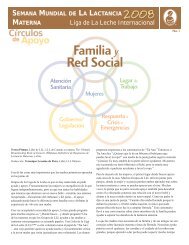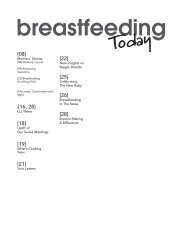Gaining, Gulping, Grimacing? - LLLI - La Leche League International
Gaining, Gulping, Grimacing? - LLLI - La Leche League International
Gaining, Gulping, Grimacing? - LLLI - La Leche League International
You also want an ePaper? Increase the reach of your titles
YUMPU automatically turns print PDFs into web optimized ePapers that Google loves.
tear- sheet toolkit 485<br />
<strong>Gaining</strong>, <strong>Gulping</strong>, <strong>Grimacing</strong>?<br />
Is your baby thriving . . . but nursing is a struggle? Do these sound familiar?<br />
1. My baby chokes and gulps and splutters when she nurses.<br />
2. My breasts always feel full, and/or they spray when my milk<br />
releases.<br />
3. My baby “wrestles” with my breast, pulling off, crying, tugging,<br />
arching.<br />
4. My baby has lots of wet and poopy diapers.<br />
5. My baby is colicky, or gassy, or spits up frequently.<br />
6. My baby sometimes—or always—has frothy or greenish stools.<br />
Some diapers may have a little blood.<br />
7. My baby is gaining rapidly, or grew fast at first with weight gain<br />
dropping as fussiness increased.<br />
8. My baby rarely falls asleep at my breast; nursing is an athletic event.<br />
9. My baby will nurse only for food, not for comfort.<br />
10. My baby grimaces when she nurses.<br />
11. My baby often seems to have uncomfortable intestines.<br />
12. I try to make a point of nursing on both breasts each time.<br />
13. If it’s been less than two hours, I look for some cause for fussiness<br />
other than hunger.<br />
Those can mean a baby who’s getting “too much soup, not enough<br />
cheesecake.” The milk that builds up in our breasts between feedings tends<br />
to be a lower- fat milk, changing gradually from “soup” to “cheesecake”<br />
through the feeding. If we have too much milk, she may not get through<br />
all the soup at one sitting. If we switch breasts partway through the nursing<br />
“to make sure she takes the other side,” or if we try to space our nursings<br />
to two hours or more, that can mean the baby plows through a whole lot<br />
of soup and never gets much cheesecake. She grows fine. But without the<br />
extra fat, milk travels fast through her intestines, doesn’t break down fully,<br />
n<br />
<strong>La</strong>le_9780345518446_3p_all_r6.indd 485 6/2/10 3:02:51 PM<br />
© 2010 <strong>La</strong> <strong>Leche</strong> <strong>League</strong> <strong>International</strong>, The Womanly Art of Breastfeeding, Chapter 20.
486 the womanly art of breastfeeding<br />
and can ferment in her large intestine, causing gas, discomfort, and frothy<br />
green stools.<br />
And then there’s the fire hose effect. All that milk can squirt into your<br />
baby’s mouth, making her feel she must swallow or drown. Not much fun.<br />
You may find your baby is happier and more settled if you let her “get to the<br />
bottom of the barrel,” where the cheesecake is, by doing two things:<br />
• Offer to nurse whenever she shows interest, even after just a few<br />
minutes. Shorter intervals mean the higher fat milk is still there.<br />
• If she’s happy on one side, leave her there. If that side isn’t nice and<br />
soft afterward, use it again next time. Using one side for a couple<br />
hours may be all it takes. Some need to spend four to six hours on one<br />
side before using the other. Use your instinct more than the clock.<br />
The over fullness on the other side cuts back production, which is<br />
what you want. If you’re too overfull, nurse or express just enough for<br />
comfort, then go back to the side you’re trying to soften.<br />
These sound like rules, but they’re just temporary reminders to help you<br />
get past two ideas that may have started the problem—making a point of<br />
switching sides, and delaying feedings.<br />
As your supply settles down, you may worry that you’ve “lost your<br />
milk.” No more heavy, leaking breasts or choking. If your baby is still getting<br />
lots of wet and poopy diapers, and looks relaxed and comfortable during<br />
and after nursing, these are signs of good milk supply. If she wants to<br />
increase it, all she has to do is nurse more often, or start taking both sides<br />
sometimes. Trust her, and trust your body.<br />
You should begin to see a happier baby and easier feedings within a few<br />
days. If not, check with an LLL Leader or visit llli.org for more ideas.<br />
<strong>La</strong>le_9780345518446_3p_all_r6.indd 486 6/2/10 3:02:51 PM<br />
© 2010 <strong>La</strong> <strong>Leche</strong> <strong>League</strong> <strong>International</strong>, The Womanly Art of Breastfeeding, Chapter 20.











